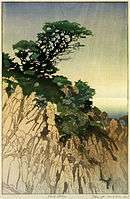Dennis Ichiyama
Dennis Ichiyama is an artist focusing on woodblock prints and former professor of Visual Communications Design at Purdue University in West Lafayette, Indiana..[1][2][3][4]
Early life and education
Ichiyama attended the University of Hawaii-Manoa where he obtained his B.F.A., having grown up in Hawaii. He went on to get his M.F.A. in Graphic Design from Yale University in 1968, studying under Paul Rand to learn how to create within limitations. From 1976 to 1978, Ichiyama studied as a post-graduate student at Allegemeine Gewerbeschule in Basel, Switzerland.[5][6]
Career
In 1999, Ichiyama became the designer-in-residence at the Hamilton Wood Type and Printing Museum in Two Rivers, Wisconsin, working with historic wood type.[7][8][9][10]
During his career he has received several fellowships[11] and study grants,[12][13] and many awards in Print,[14] Communication Arts, Creativity, and HO publications' annual design competitions. He has contributed to the book Contemporary Designers.[15] and the book Hamilton Wood Type, A History in Headlines.
In late 2017, Ichiyama was forced to retire from Purdue University.
Art
Ichiyama's art focuses on woodblock prints. He uses opaque and transparent inks to layer wood block prints of letters on top of one another.[16] By doing this, he creates new shapes and forms within the remaining positive and negative space. His work can be found in many library collections in the US, Zurich, Rome, and Corunda, as well as the National Art Museum and Gallery[17]
Ichiyama has also designed a number of commercial trademarks.[18]
References
- Harry Vernon Anderson (July 1990). Interior Design. Interior Design Division of Whitney Communications Corporation. p. 33.
- Bookways, Issue 10-16. W. Thomas Taylor, Incorporated. 1994. p. 10.
- How. 19, Issues 1-3. RC Publications. 2004. p. 50.
- The APHA Newsletter: A Publication of the American Printing History Association. The Association. 2008. p. 35.
- Ambrose, Gavin; Aono-Billson, Nigel (2017-09-07). Basics Graphic Design 01: Approach and Language. Bloomsbury Publishing. ISBN 9781350034235.
- "This Just In: Identity Manual Collection". letterformarchive.org. Retrieved 2019-06-10.
- Lisa Cyr; Lisa Hickey; Cheryl Dangel Cullen (1 March 2007). Little Book of Big Promotions. Rockport Publishers. pp. 13–. ISBN 978-1-61673-646-0.
- How. RC Publications. 2004. p. 50.
- The APHA Newsletter: A Publication of the American Printing History Association. The Association. 2008. p. 35.
- "Purdue Profiles: Dennis Ichiyama". www.purdue.edu. Retrieved 2019-06-10.
- Indiana Arts Commission (1987). Annual Report. Indiana Arts Commission. p. 32.
- Humanities. The Endowment. 1985.
- National Endowment for the Humanities, Twentieth Annual Report 1985. p. xxxviii.
- Graphic Design USA. (2003). American Graphic Design Awards. Visual Reference Publications. pp. 39–. ISBN 978-1-58471-028-8.
- Roland Turner (1985). The Annual Obituary. St. Martin's. p. 267.
- "Contemporary Visions in Wood Type". Baseline Magazine.
- National Art Museum and Gallery Guide. Art Now, Incorporated. 1988. pp. CD–123.
- David E. Carter (1975). The Book of American Trade Marks. Century Communications Unlimited.
